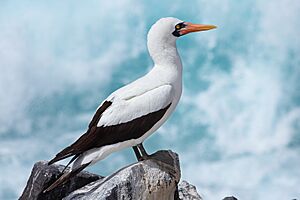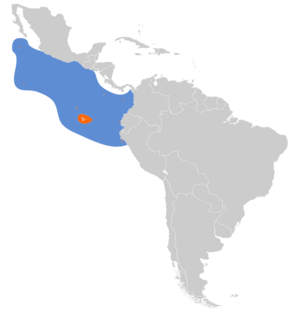Nazca booby facts for kids
Quick facts for kids Nazca booby |
|
|---|---|
 |
|
| Adult on Española Island, Galapagos Islands | |
| Conservation status | |
| Scientific classification | |
| Genus: |
Sula
|
| Species: |
granti
|
 |
|
The Nazca booby (Sula granti) is a large seabird that lives in the eastern Pacific Ocean. It belongs to the booby family, called Sulidae. This bird was first described in 1902 by Walter Rothschild. For a long time, people thought it was just a type of masked booby. But in 2002, scientists found out it was a separate species. They looked at its genes and how it behaved.
The Nazca booby has a typical booby shape. It has a long, pointed orange-yellow beak. It also has a long neck and a body built for flying fast. Its wings are long and thin, and its tail is pointed. Adult Nazca boobies are bright white. Their wings are black and white, and their tail is black. They also have a dark mask-like area on their face.
Contents
Discovering the Nazca Booby
Walter Rothschild sent a team to the Galapagos Islands in 1897. Their goal was to study the animals living there. Rothschild noticed a special kind of booby. He and William Robert Ogilvie-Grant first thought it was the Peruvian booby.
Later, in 1902, Rothschild decided it was a new species. He named it Sula granti. He later changed his mind and called it a subspecies of the masked booby.
However, in 1998, scientists saw something interesting. Nazca boobies on Clipperton Island did not mix with masked boobies there. This suggested they were different species.
Scientists later used DNA tests to confirm this. They found that the Nazca booby is indeed a separate species. It likely became different from the masked booby about 400,000 to 500,000 years ago.
What They Look Like
The Nazca booby has yellow eyes. Its beak is orange and pinkish. It has black skin on its face, which looks like a mask. Its feet are grey.
Adult birds are mostly white. The tips of their wings and tail are black. Female Nazca boobies are bigger and heavier than males. Their beaks are also slightly different in color. Females make squawking sounds, while males make whistling sounds.
Baby Nazca boobies are fluffy and snow white. As they grow up, their feathers turn grey. Their beaks and feet also change color before they learn to fly.
Where They Live
The Nazca booby lives in the eastern Pacific Ocean. You can find them on islands near Baja California. They also live in the Galápagos Islands. Other places include Isla de la Plata in Ecuador and Malpelo in Colombia.
How They Live
How They Find Food
Nazca boobies eat small fish. They catch these fish by diving very fast into the ocean from the sky. Their main food is the South American pilchard.
They also eat flying fish, anchovies, and squid. This is especially true during El Niño events. During El Niño, there are fewer sardines available. Because females are larger, they tend to eat bigger fish. They also dive deeper to find food.
Reproduction and Life Cycle
Nazca boobies build their nests near cliffs. They prefer bare ground with little or no plants. The male bird chooses and protects a nesting spot. Then, he tries to attract a female.
Like many seabirds, Nazca boobies live a long time. However, they do not have many babies each year. Their young also take a long time to grow up.
A female usually lays one or two eggs. Even if two eggs are laid, it's common for only one chick to survive. The first chick to hatch is usually bigger. It often gets most of the food. This means the younger, smaller chick may not survive.
Boobies do not have a bare patch of skin to warm their eggs. Instead, they use the skin on their webbed feet. They also use heat from their chest. Their feet have many blood vessels, especially when they are nesting. Both parents help care for the chicks.
Raising chicks takes a lot of energy from the parents. Their bodies change during the nesting season. Both parents lose weight and their immune system activity goes down. If there isn't enough food, parents might decide not to nest that year. Food availability depends on ocean currents and climate patterns like El Niño.
Other Animals They Interact With
The vampire ground finch sometimes feeds on the blood of the Nazca booby.
Protecting the Nazca Booby
The Nazca booby is listed as Least Concern by the IUCN. This means it is not currently in danger of disappearing. Scientists believe their numbers might be decreasing a little. However, this drop is not big enough to put them in a threatened category.
Some things that can affect Nazca booby populations include overfishing. This means too many fish are caught, leaving less food for the boobies. Marine pollution is another problem. This includes trash and chemicals in the ocean.
Gallery








